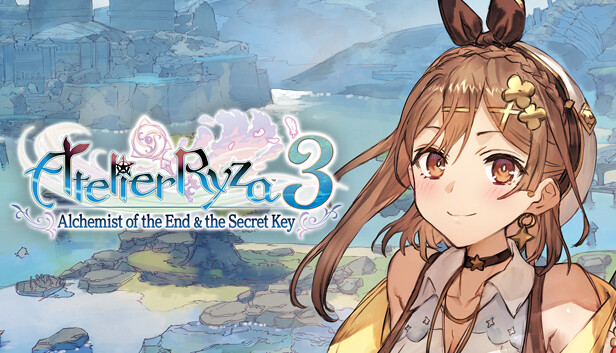Full gameplay experience can be found on Twitch & Youtube.
Playtime: 53 Hours [Hard Mode]
Platform: PS5
What an adventure. Atelier Ryza 3 ends the summer adventures of Ryza & Co - with some new character additions, lots of new areas to explore & journeys to be had, as well as lots of quality of life changes - at least, from what I remember that seem to be upgrades from the previous Ryza games. As of the time of this writing, we have completed the core main story, and a decent chunk of sidequests as well as synthesized some mid-level equipment.

First-up: The QoL improvements that I immediately noticed
You can pick up items while you're still running. There's still an animation for picking items up (without using tools), and if this was previously in Sophie 2 or other Ryza games, I really didn't remember it. Being able to just press X and keep on running through the massive world was really nice. It kept me moving and in the action and immersion more, and the animations were there if you wanted to stop and breathe in the fresh air too.
The game ran smooth too. Like butter. Load times were pretty rare, but when they did happen it was no longer then 5-10 seconds, and the camera moved nice and smooth. I don't think we had any frame drops the whole playthrough. When I peeked at Sophie 2 (the previous Atelier entry), it had a bit of FPS lag in some zones, so Ryza 3 running this smooth surprised me a lot.
On environments, exploration and general adventuring:

The world is extremely large, with all kinds of secrets to find. At times, birds may guide you to hidden treasure or hidden uncovered miniboss fights, and you may even want to follow the off-beaten trail to see what lies ahead. Environments were all very varied from small oceans, to forests, to desert biomes each with their own monster characteristics & gatherable materials - as expected from Atelier.
What did feel new, however, was the way that the zones were laid out. Ryza 3 felt like it took a new approach to the world-size and pushed the envelope of open world fields lush with all kinds of materials and enemies to encounter and fight. The world never felt empty, and there was always something new to pick up or find, or to even fight.

Ryza 3 also incorporated "random quests" which can be alikened to Fates from FFXIV or world quests from Guild Wars 2, though on a smaller single player scale of course. Some random NPCs that you pass by may want a synthesis complete, or to send you to fight a monster with a time limit for skill points (these skill points are utilized in a skill tree to unlock more recipes). They were nice little sidequests that you had the option to go off and fulfill if you felt the need or desired the reward - with no real pressure outside of the generous in game time limit to complete them.
Characters:

The cast of Ryza 3 was very fleshed out. The cast size is rather large - omitting actual size for no spoilers, but there are many returning characters from previous entries, as well as new characters. Some of these characters were previously already established as fantastic characters with fun friends which had lovable dialogue and great endearing moments.
Over all the cast of Ryza 3 meshed so well with eachother - a real group of adventuring friends that all had a stake in the journey as well as a stake in the friendship of the group itself. I absolutely adored this team, and it was a very healthy balance of content that each member was able to deliver. Nothing felt forced, and all of the lines characters had felt very implicit and important to the core message of what was currently happening in-game.
On Synthesis:

Synthesizing in Atelier Ryza has been far streamlined from the previous non-Ryza entries. This is mostly unchanged from previous Ryza titles - there are a few methods to synthesizing with in game mechanics for each one, but the approach is extremely simple on the surface. Place ingredient gathered on the field or crafted into loop that matches the element (this is all on the tooltip of the item), and get bonus. Rinse and repeat until all slots are filled and item is complete.
Further synthesizing includes methods to 'item rebuild'; a way to continue crafting from where you may have left off, if you didn't quite finish everything you wanted with the limited quantity of ingredients, as well as reinforcing equipment which allows you to put special effects on weapons as well as instant stat-sticks. These systems are mostly the same as previous entries, with the exception of the new Super Trait slots. These are new slots placed on all crafts specific to a higher-tier effect or trait for the crafted item for very powerful effects.
Secret Keys:

Secret keys are an interesting new game mechanic and central to the plot. These items replace some field items, and are able to give bonuses in various different ways. For example, you can equip keys on characters to provide stat bonuses or extra classes, or you can utilize keys in your synthesis recipes to provide further bonuses such as higher quality, or more ingredient slots. Furthermore, you can utilize keys to dispel barriers in the field, to unlock chests, and even to give yourself buffs in combat to varying degrees.
These keys were very integral to enjoying some of the new functions that they allow - at first, the key system was a bit confusing and daunting. It felt kind of added on late - but by mid to endgame, the keys were really pulling their weight and allowed all kinds of crafting to be completed that would have otherwise been much harder without these keys. They also largely contributed to difficult fights - they can really turn the tide on a large scale enemy fight due to the powerful nature of the buffs they provide, such as invincibility for 30-40 seconds, or faster action time in combat for quicker ability use.
All-in-all, these keys were a bit confusing to start with, but by the end of the adventure, they had grown on me a lot. It's a feature I hope to see return in some facet in future titles due to versatility of the keys.
On Combat:

Personally, the combat in Ryza 3 blew me away. I was very impressed at the surface-level but depth-reaching tactics that this combat incorporated. On the top level, you'll have normal attacks, skills, defending and items as well as an AI swap to be more 'aggressive' or to be more 'supportive', as well as real-time character swapping (to change the played character).
As you attack more, you gain AP as well as CC - AP can be used for skills, and CC can be used for utilizing items. You gain tactics points for fulfilling orders requested by the team, which raise your T-LV and allow for further skills to be used based on the T-LV set. It may sound a little confusing, but it's pretty simple still in practice.

As you get further into the combat though, it gets far deeper. You are able to string skill combos together to activate stronger skills, assist your allies in completing orders that they request to raise the tactics level, swap party members out with switch skills for extra damage from the backline, utilize the mentioned keys to provide buffs to yourself or the entire team, and even 'flash guard' (Guarding at the precise moment an enemy attacks you, to minimize the damage even further). The ceiling of potential for combat in this title is vast, and has many ways of approaching it.
Due to the complexity of the system, it may be hard to perfect every approach to combat - but with the customization you are able to set, and characters you are able to use, I believe there is an approach to this combat that everyone can find and enjoy. Whether you want to utilize items in combat effectively, or use flashy combos, or play as the tank flash guarding attacks with high agro - there's a role for everyone to find and enjoy in this combat. The animations are incredibly beautiful as well.
On game balance (Hard Mode) -
While balance is completely and directly tied to how much you synthesize, gather, and/or craft, there were a few points in the game where the difficulty kind of just spiked - this wasn't too much of an issue, as when this happens it's sort of just a sign to go craft better things and it's certainly nothing new - but this does still happen. Unless, of course, you craft 999 quality items as soon as possible with maxed traits with a perfect understanding of synthesizing (I'll admit, not me. I'm not the greatest synthesizer :) )
Other then these very clear difficulty spikes - that, by the way, are probably just there to prepare you for future encounters - the balance felt just right. One boss towards the end was a massive spike as expected, but other then this encounter, the balance felt right - most of the time. Especially as future game mechanics open up and you get more and more used to the combat system.
During the mid-game there were encounters that did seem to take a while due to tanky monsters - punis, even - but looking back now, I believe I wasn't utilizing all of the game's combat mechanics and functions to the fullest, which may have drastically held us back. That said, encounters were still winnable, and the game completable, without having maximum quality ultimate gear. I think that says a lot for the balance. As long as you take decent care of your equipment periodically and take spike encounters (if they happen) as the poke to get your gear up to date - game balance felt just right.
Dialogue to gameplay ratio:
It's a bit of a running joke, as it's no surprise I play some RPGs differently and tend to beeline the story due to my own immersion reasonings, and in some games, we end up in what I tend to call 'cutscene hell'. This is when cutscenes stack up on the same zone entry spot or same character spot, and sometimes even block the main story progress until it's taken care of. With tens of quests stacked up back to back, sometimes this can collectively take hours to sift through before getting to the real core of the story. Due to this, I think I should probably mention the ratio of dialogue to gameplay - and this isn't a negative thing at all. I'm weird.
Anyway, the good news is that this issue has mostly been alleviated. Due to the size of the world, it's a lot less common now to end up in the above scenario as quests and dialogue are a lot more spread out. It -can- still happen, but if you are similar to me, I don't think it will be too much to worry about now. The gameplay of Ryza 3 definitely took the main spotlight, and the dialogue - while present - didn't reach the point of being too overwhelming or having too many sidequests to do. It was a great balance; I'd probably put it to 60:40 dialogue to gameplay - but the dialogue that was important was pretty clear and succinct to the point and didn't overstay the welcome at all. This is also where the character and worldbuilding come into play as well.
Music:
The soundtrack of Ryza 3 was spectacular. The tracks in the game were immersive, and buffed the environmental effect of the zones to a large degree. The sound design was on point, with even gusts of the winds being audible at times. The combat music was in my opinion fantastic, and the event music scenes were always fitting. Music is important to me in all games and I am incredibly glad Gust was able to nail the soundtrack again.
Short list of improvements I hope to see in the future:
- checkbox for supertraits that are usable on current piece of gear being synthed
- select all option for item reduction if filters are set
- further filter improvements in synthesizing
- pristine key item duplication - This is a difficult one to mention, but as the game has a heavy reliance on the key system, you'll likely need to craft 50-100+ keys to fully utilize them which can take an excessive amount of materials.
- more mini-map options for multiple sized minimaps outside of the large overlay, and more settings in game such as larger font size
- a̶l̶l̶o̶w̶ t̶h̶e̶ L̶1̶ b̶u̶t̶t̶o̶n̶ t̶a̶p̶ t̶o̶ q̶u̶i̶c̶k̶-̶c̶y̶c̶l̶e̶ t̶o̶o̶l̶s̶, w̶h̶i̶l̶e̶ a̶l̶s̶o̶ k̶e̶e̶p̶i̶n̶g̶ h̶o̶l̶d̶i̶n̶g̶ L̶1̶ t̶o̶ c̶h̶a̶n̶g̶e̶ t̶h̶e̶m̶ t̶h̶r̶o̶u̶g̶h̶ t̶h̶e̶ r̶i̶n̶g̶ [This exists! I'm silly :)]
All in all, I found Atelier Ryza 3 to be a brilliant experience. I personally enjoyed this adventure more than the past two entries combined. The character buildup that Ryza received greatly played in her favour and the world building that was expanded on made for a fantastic world to continue the summer journeys in. I feel rather bittersweet that this adventure has come to an end, but with it hopefully will pave the way for even further Atelier titles and journeys. I really hope the exploration / adventuring theme continues - it was one of my favorite worlds to explore in an RPG in quite a while, with beautiful characters to tie it all together.
Thank you for all your hard work Koei Tecmo & Gust - and I hope to continue to experience these incredible stories in many further entries. See you in the next Atelier title!

Thanks for taking the time to consume this, and hopefully you enjoyed these impressions of Ryza 3.
Thoughts or comments? Leave a post & let me know below!



